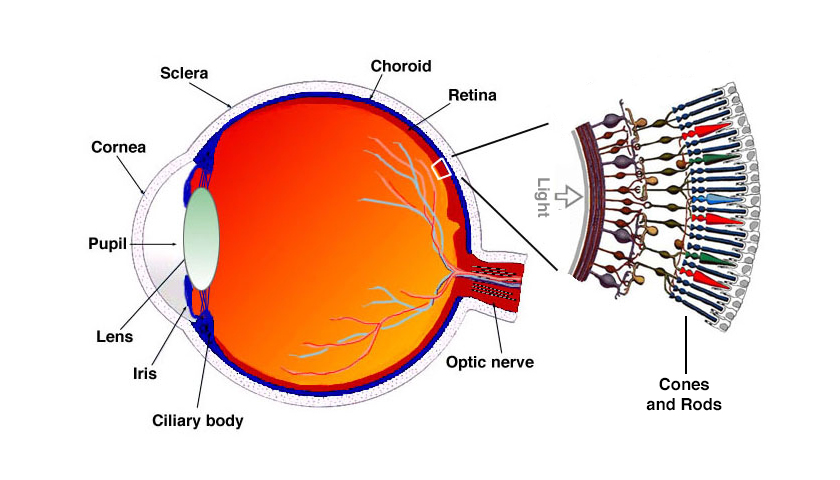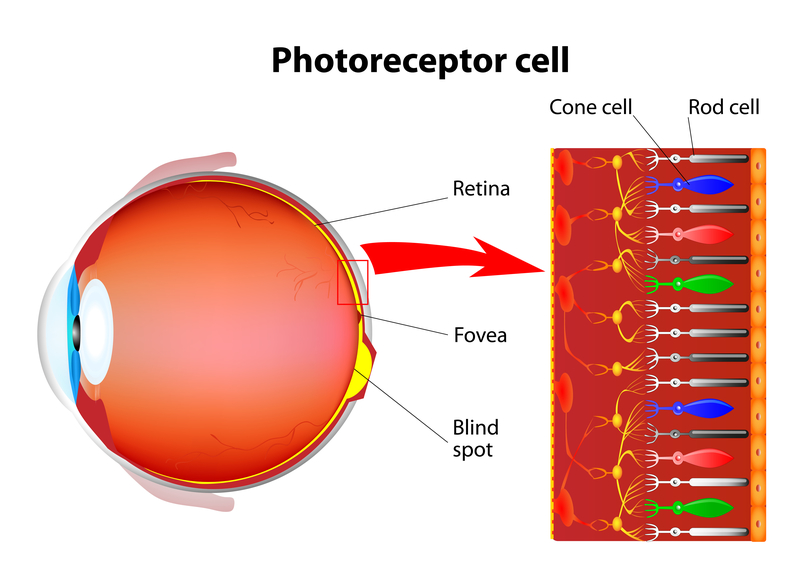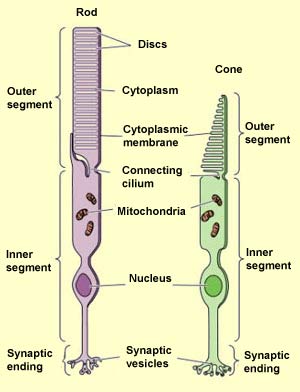Rod cells are highly sensitive to light and function in nightvision whereas cone cells are capable of detecting a wide spectrum of light photons and are responsible for colour vision. The more rods that are connected to each nerve cell the more sensitive the eye is under low light conditions.
You know that our retina has two types of light-sensing cells.
. The two kinds of receptor in the eye are rods and cones. Cones rely on light-sensing molecules that bind together to make up visual pigments. The receptors of the back of the eye enable humans to see the world in color and in detail.
They are very sensitive but color blind. Study the retina rods the cones and fovea and metaphors to help you remember what each photoreceptor. The human eye has over 100 million rod cells.
Out of 167 red cones tested 119 signaled white. Cones require a lot more light and they are used to see color. Rods and Cones are the photoreceptors useful in providing vision to the eyes.
In fact this region located at the center of the retina consists exclusively of cones. The eyes detect different colors by using the _____. Human dichromats lack one of the three cone pigments either because the corresponding gene is missing or because it exists as a hybrid of the red and green pigment genes see Figure 1113For example some dichromats lack the green pigment gene altogether while others have a hybrid gene that is thought to produce a red-like pigment in the green cones.
Your eyes contain 7 million cones which help you see color and detail. Afoveas bcones cshafts drods 52The eyes. Rods are not shown in this diagram of the retina.
The inner lining on the back of the eyeball which is sensitive to light. Abelard 2013 Interestingly the human eye has a hard job focusing all three colours at the same time. Secondly rods do not support the colour vision but cones are capable of colour vision with high spatial acuity.
Long wavelengths are the ones which appear red to us. There are 120 million light-sensing cells called rods which help you to see better in the dark. Nocturnal animals have more rod cells in their eyes as compared to humans and other animals active during the day.
The team didnt test white sensitivity among the. 51Light receptors which see best at night the _____. The conversion of light energy into sight is done by receptor cells in the _______.
Of 98 green cones tested 77 reported white light. The cones require a large amount light to operate and are functional during daylight but are almost useless at night. One transmits white light the other relays color.
Smoking reduces your night vision. Rods and cones are structurally compartmentalised. The stars and colors you see when you rub your eyes are call phosphenes.
Rods provide vision during dim light or night also known as scotopic vision whereas cones provide vision during day time or at bright light also known as photopic vision. The eyes convert light energy into neural responses that we experience as sight. Rods and cones are photoreceptive cells that cover the retina or the inner light receptive part of the eye.
These specialized cells are called photoreceptors. The eyes detect different colors by using the _____. There are four classes of receptors.
We use these for night vision because only a few bits of light photons can activate a rod. So they are basically light receptors. Photoreceptors in the retina are classified into two groups named after their physical morphologies.
What are the two types of light receptors. These receptor cells are sensitive to bright light and are specialized for color vision. Rods work at very low levels of light.
Course Title PSY 101. Rods which are used to see at night or under very low illumination. As the cone responds the wavelengths lap over.
Cone cells help in sensing colour but require bright focused light whereas rods can sense very dim scattered light. In general rods are far better for night vision because they are sensitive to low light. Cones respond to the different wavelengths of light as red green and blue-violet.
Only see in black and white but are very light sensitive thats why you see in. Rods dont help with color vision which is why at night we see everything in a gray scale. 9 Votes The retina is the back part of the eye that contains the cells that respond to light.
And these are just fun facts about eyes. The pigments get destroyed when they absorb light and must be rebuilt or recycled for the cone cells to continue sensing light. Click to see full answer.
L- receptors are ones which are most sensitive to long wavelength light. The rod cells serve the opposite function. 465 42 Views.
Cones are found in greatest density at the fovea. We have three types of cones. Light receptors which see best at night are the _____.
Light receptors that see best at night are the a foveae b cones c shafts d rods. Pages 4 Ratings 100 5 5 out of 5 people found this document helpful. School Moraine Valley Community College.
Cone Receptors are named for their cone-like shape. There are 2 types of photoreceptors in the retina. The cones are not as sensitive to light as the rods.
Light receptors which see best at night are the _____. Particularly difficult is with the blue-violet which can result in a hazy effect. Light receptors that see best at night are the a.
Especially surprising most of these cones are the white type. The process by which rods and cones become more sensitive to light in response to lowered levels of illumination is called _____. The researchers began studying salamanders because their cone cells are abundant and easy to identify.

The Eye Blue Cone Monochromacy

Rods And Cones What Role Do They Play In Macular Degeneration

0 Comments